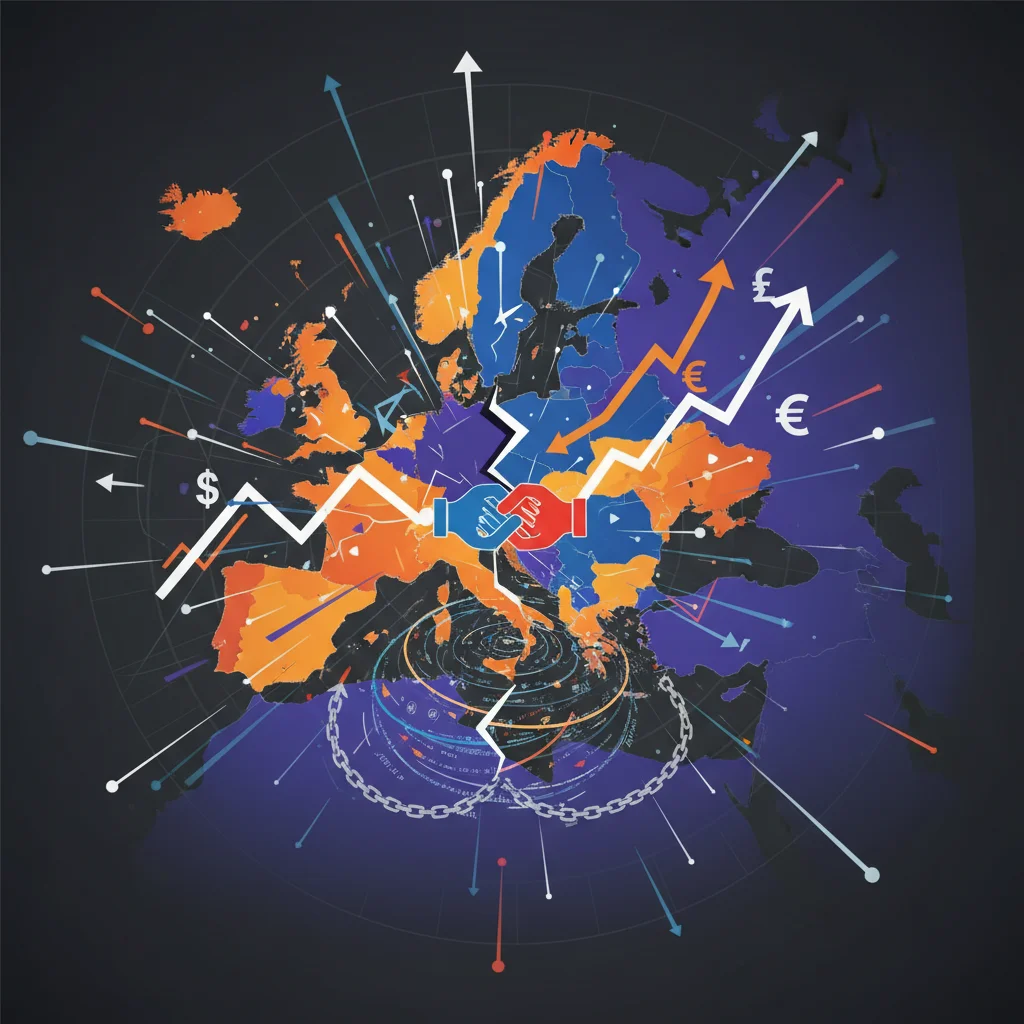
Europe’s Security Shockwave: Why a US-Russia Deal Could Reroute Global Markets
The Tremor Before the Quake: A Geopolitical Jolt with Financial Consequences
In the world of high-stakes global politics, whispers of a peace deal can be as disruptive as the drumbeat of war. A recent proposal, reportedly under discussion between the US and Russia to end the conflict in Ukraine, has sent a significant tremor through the capitals of Europe. According to a report from the Financial Times, key elements of this plan could grant Russia significant influence over the continent’s future defense and security architecture. This isn’t just a political headline; it’s a seismic event with profound and immediate implications for the global economy, international investing strategies, and the stability of the entire European financial ecosystem.
For decades, the transatlantic security alliance, anchored by NATO, has been the bedrock of European stability. This stability has underwritten economic prosperity, encouraged foreign investment, and maintained predictable market conditions. The suggestion that this foundation could be altered—without full European consensus—has triggered a frantic reassessment. European leaders are now scrambling not just to influence the diplomatic outcome, but to fundamentally rethink and reinforce their own security. This scramble is not without a hefty price tag, one that will be paid from national budgets, reshape industrial priorities, and ultimately impact every facet of European finance, from sovereign debt to the stock market.
Deconstructing the Deal: What’s on the Table?
To understand the market’s anxiety, we must first look at the core of the reported proposal. While details remain fluid, the central components that have caused alarm in Brussels, Berlin, and Paris involve potential long-term security guarantees that could limit NATO’s military presence in Eastern Europe. The FT’s reporting suggests that such a deal could effectively create a “buffer zone,” giving Russia a de facto veto over security arrangements in its neighboring countries (source). This is seen by many European strategists as a return to a “spheres of influence” model of geopolitics, a paradigm Europe has spent over 70 years trying to escape.
The potential consequences are far-reaching. For investors and business leaders, the key takeaway is a dramatic increase in perceived risk across the continent. A security framework perceived as fragile or subject to Russian influence could deter foreign direct investment, raise borrowing costs for European nations, and introduce a new level of volatility into currency and equity markets. The core principles of collective defense and predictable alliances, which have long been priced into European assets, are now being questioned.
The Trillion-Dollar Bug: How AI and New Financial Models Are Fuelling the War on Superbugs
The Economic Domino Effect: From Defense Budgets to Your Portfolio
A fundamental shift in Europe’s security landscape will not be contained to the realm of diplomacy. It will unleash powerful economic forces that will reshape markets and industries for years to come. Understanding these dynamics is crucial for anyone involved in finance, trading, or strategic business planning.
1. The Defense-Industrial Complex: A Bull Market in Security
The most immediate and visible impact is the surge in defense spending. Nations across Europe, jolted into action, are dramatically increasing their military budgets to meet and exceed the NATO target of 2% of GDP. Germany’s Zeitenwende (“turning point”) policy, which includes a €100 billion special fund for its military, is just one example. This represents a massive reallocation of capital within the European economy.
For the stock market, this translates into a sustained bull run for aerospace and defense companies like Rheinmetall, BAE Systems, and Thales. However, this capital redirection comes at a cost. Increased defense spending can crowd out investment in other critical areas like infrastructure, green energy, and digital transformation. This creates a complex macroeconomic picture where one sector booms while others may face austerity, a crucial variable in the study of economics.
2. Market Volatility and the Geopolitical Risk Premium
Markets despise uncertainty. The prospect of a new, untested European security order introduces a significant “geopolitical risk premium” on European assets. International investors will demand higher returns to compensate for the elevated risk, potentially leading to:
- Currency Fluctuations: The Euro (EUR) could face downward pressure as investors seek the relative safety of the US Dollar (USD).
- Sovereign Debt Spreads: The gap between the borrowing costs of Germany (seen as safer) and other Eurozone nations could widen.
- Equity Market Volatility: European stock indices may experience more significant swings based on geopolitical headlines, making short-term trading a more hazardous affair.
This new reality requires a shift in investing strategy, where geopolitical analysis becomes as important as traditional financial modeling.
Mapping the Financial Implications of New Security Realities
To clarify the direct link between the proposed security changes and their economic consequences, the following table breaks down the key elements and their potential market impact.
| Proposed Security Change | Potential Economic & Financial Implication |
|---|---|
| Limits on NATO’s Eastern Flank Presence | Increased perceived risk in Eastern European economies; potential capital flight and higher borrowing costs for nations like Poland and the Baltic states. |
| De Facto Russian Veto on Regional Security | Higher risk premium on all European assets; discourages long-term foreign direct investment (FDI) due to policy uncertainty. |
| Push for European “Strategic Autonomy” | Massive increase in EU defense spending, boosting defense stocks but potentially straining national budgets and increasing sovereign debt. |
| Uncertainty over US Security Guarantee | Weakening of the Euro against the US Dollar; increased demand for safe-haven assets like gold and US Treasury bonds. |
3. The Role of Banking and Financial Technology
The financial system remains a key battleground. The existing sanctions regime against Russia has placed enormous compliance burdens on the global banking sector. Any new security arrangement would require a re-evaluation of these measures. Furthermore, the drive for strategic autonomy extends into the financial domain. European leaders are increasingly concerned about their reliance on US-dominated financial infrastructure.
This could accelerate projects aimed at creating European alternatives for payment processing and financial clearing. It also puts a spotlight on the world of financial technology (fintech). Advanced AI and machine learning platforms are becoming essential for banks to navigate the complex web of sanctions and monitor for illicit financial flows. Simultaneously, there are growing concerns that rogue states could leverage emerging technologies like blockchain and decentralized finance (DeFi) to create alternative financial ecosystems, posing a new challenge to the established global order (source).
Lula's High-Wire Act: Balancing Brazil's Climate Goals with a Multi-Billion Dollar Oil Bet
A Continent at a Crossroads: The Price of Security
Europe is facing its most significant strategic reckoning since the end of the Cold War. The jolt from the US-Russia talks has served as a powerful catalyst, forcing a conversation that many had postponed for decades. The path forward involves difficult choices with steep economic trade-offs. Building a credible, independent European defense capability will require trillions of euros in sustained investment over the next decade. This will test political will, fiscal discipline, and the very cohesion of the European Union.
For business leaders, investors, and finance professionals, the message is clear: the era of treating geopolitical risk as a background variable is over. It is now a primary input for any serious economic forecast or investment thesis. The security decisions made in the coming months will not only draw the new map of Europe but will also determine the flow of capital, the valuation of assets, and the trajectory of the global economy for a generation.
The Goliath of Mumbai: Inside Reliance's High-Stakes War for India's Trillion Retail Market
The scramble for security is on, and its impact will be felt far beyond the corridors of power—it will be reflected in stock tickers, bond yields, and balance sheets across the world. Watching Europe’s response is no longer just a matter of political curiosity; it’s a financial necessity.


